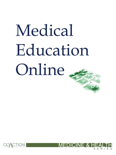
Medical Education Online
Scope & Guideline
Advancing medical education through open access innovation.
Introduction
Aims and Scopes
- Innovative Teaching Methods:
The journal emphasizes the exploration and development of innovative teaching methodologies, including blended learning, flipped classrooms, and online education, aimed at improving student engagement and learning outcomes. - Assessment and Evaluation:
Research on various assessment strategies, such as competency-based evaluation and objective structured clinical examinations (OSCEs), is a core focus, aiming to enhance the reliability and validity of assessments in medical education. - Interprofessional Education:
There is a consistent emphasis on interprofessional education (IPE) to foster collaboration among healthcare professionals, enhancing teamwork and improving patient care outcomes. - Diversity, Equity, and Inclusion:
The journal highlights the importance of diversity, equity, and inclusion in medical education, addressing systemic biases and promoting equitable healthcare practices. - Mental Health and Well-being:
Research focusing on the mental health and well-being of medical students and healthcare professionals is a significant area of interest, exploring the impacts of stress, burnout, and institutional support. - Integration of Technology:
The journal explores the integration of technology in medical education, including the use of artificial intelligence, virtual reality, and online learning platforms to enhance training and educational experiences. - Patient-Centered Care:
There is a focus on developing curricula that emphasize patient-centered care, including communication skills and understanding the social determinants of health.
Trending and Emerging
- Online and Hybrid Learning Models:
The shift towards online and hybrid learning models has gained momentum, particularly post-COVID-19, with research focusing on effective online teaching strategies and student engagement in virtual environments. - Mental Health Awareness:
There is an increasing focus on the mental health and well-being of medical students, with studies exploring interventions and support systems to address issues of burnout and stress. - Competency-Based Education:
Competency-based education is becoming a prominent theme, with research aimed at redefining curricula to ensure that graduates possess the necessary competencies for effective practice. - Social Accountability in Medical Education:
The trend towards social accountability in medical education is gaining traction, emphasizing the need for curricula that address healthcare disparities and prepare students for community-oriented practice. - Integration of Artificial Intelligence:
The exploration of artificial intelligence in medical education is an emerging trend, with research investigating its potential to enhance learning experiences and assessment methods. - Patient-Centered and Inclusive Care:
There is a growing emphasis on patient-centered care and inclusivity in medical curricula, with studies advocating for training that addresses the needs of diverse populations. - Interprofessional Collaboration:
Research focusing on interprofessional collaboration is on the rise, highlighting the importance of teamwork among healthcare professionals to improve patient outcomes.
Declining or Waning
- Traditional Lecture-Based Learning:
There is a noticeable decline in research focused on traditional lecture-based learning formats, as more institutions adopt interactive and technology-driven educational approaches. - Standardized Testing Practices:
Research on standardized testing practices, particularly those that do not incorporate formative assessments or feedback mechanisms, has decreased, reflecting a shift towards more holistic and competency-based evaluations. - Cultural Competency Alone:
The focus on cultural competency as a standalone concept is waning, with increasing recognition of the need for a more integrated approach to diversity and inclusion that addresses systemic issues. - Passive Learning Techniques:
The prevalence of studies advocating for passive learning techniques, such as rote memorization, has diminished, as there is a stronger emphasis on active learning and student engagement. - Disciplinary Silos:
Research that maintains a strict focus on single disciplines without interdisciplinary collaboration is less common, indicating a trend towards integrated curricula that promote interprofessional education.
Similar Journals
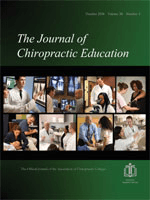
Journal of Chiropractic Education
Cultivating a community dedicated to chiropractic advancement.Welcome to the Journal of Chiropractic Education, a pivotal academic platform dedicated to advancing the field of chiropractic education and practice. Published by BRIGHTHALL & ALLEN PRESS PUBL SERVICES, this journal boasts an ISSN of 1042-5055 and an E-ISSN of 2374-250X, ensuring a broad accessibility for researchers, educators, and healthcare professionals. With a distinguished ranking in the third quartile within the chiropractic category in 2023, and a notable position as the 5th in Scopus rankings for Health Professions in Chiropractics, the journal serves as a vital resource for innovative research and comprehensive reviews. Spanning a converged period from 2017 to 2023, it emphasizes the importance of evidence-based practices and educational methodologies that enhance chiropractic training. Although the journal is not openly accessible, it continues to strive towards fostering an engaged academic community dedicated to the growth and evolution of chiropractic education. Join us as we explore the latest findings, share insights, and elevate the standards of chiropractic practice through rigorous scholarship.

Advances in Medical Education and Practice
Empowering Educators, Enriching Medical PracticeAdvances in Medical Education and Practice (ISSN: 1179-7258, E-ISSN: 1179-7258) is a prominent open-access journal, published by Dove Medical Press Ltd since 2010, with a specific focus on the evolving landscape of medical education and training. Based in the United Kingdom, this journal aims to disseminate high-quality research and innovative practices that enhance educational strategies in medical and health professions, providing a platform for scholars, educators, and practitioners to share advancements that influence curriculum development, teaching methodologies, and assessment techniques. With impressive rankings in Scopus, positioned in the top quartile of educational journals (Q2 in Education, Rank #517/1543), and a respectable impact in the 66th percentile, it is a vital resource for those invested in enhancing the quality of medical education worldwide. Researchers, professionals, and students will find valuable insights in its comprehensive collection of articles, ensuring they stay at the forefront of advancements in medical education.
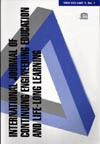
International Journal of Continuing Engineering Education and Life-Long Learning
Fostering Innovation in Continuing Engineering Education.Welcome to the International Journal of Continuing Engineering Education and Life-Long Learning, a peer-reviewed scholarly journal committed to advancing the discourse in the fields of education, e-learning, and engineering. Published by InderScience Enterprises Ltd in the United Kingdom, this journal serves as a vital resource for researchers, educators, and professionals seeking to explore innovative approaches to lifelong learning and continuing education within engineering disciplines. With an ISSN of 1560-4624 and an E-ISSN of 1741-5055, the journal reflects an ongoing commitment to academic rigor, featuring contributions that span from 1986 to the present. Although classified in the fourth quartile of Scopus rankings in both education and engineering categories, the journal embraces the evolving landscape of technological integration in education, offering a platform for the dissemination of cutting-edge research and practical applications. We invite you to delve into the insightful articles that strive to equip engineering professionals with the knowledge necessary to maintain relevance in an ever-changing world.
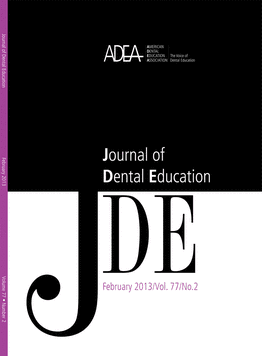
JOURNAL OF DENTAL EDUCATION
Transforming Learning in DentistryWelcome to the JOURNAL OF DENTAL EDUCATION, a leading peer-reviewed publication in the fields of dentistry and education, published by Wiley. Established in 1946, this journal remains at the forefront of dental education research, providing critical insights and advancements that shape the future of dental practice and academia. With an impressive impact factor and a ranking in the Q2 quartile for Dentistry, Education, and Medicine, it stands as a vital resource for professionals, educators, and students alike. The journal encompasses a wide array of topics, including innovative teaching methodologies, curriculum development, and evidence-based practice in dental education. Although it does not offer open access, the journal's content is accessible through various academic databases, ensuring researchers can stay informed on the latest trends and findings. As it continues to evolve, the JOURNAL OF DENTAL EDUCATION remains committed to fostering excellence in dental education and contributes significantly to the academic discourse in this essential field.
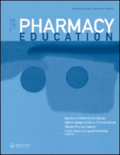
PHARMACY EDUCATION
Transforming knowledge into practice in pharmacy education.PHARMACY EDUCATION, an esteemed journal published by the INTERNATIONAL PHARMACEUTICAL FEDERATION, is dedicated to advancing the field of pharmacy education through high-quality research, reviews, and innovative practices. With an ISSN of 1560-2214 and an E-ISSN of 1477-2701, this journal provides a vital platform for educators, researchers, and professionals to discuss contemporary issues and opportunities within pharmaceutical education. Recognized for its relevance, it holds a Q4 ranking in Education and Q3 in both Pharmaceutical Science and Pharmacy as of 2023. Despite its Scopus rankings reflecting a growing niche, with positions such as 30/45 for Pharmacy in Health Professions, it showcases a commitment to nurturing the next generation of pharmacy practitioners. As a crucial resource for enhancing pharmacy curricula and pedagogical strategies, PHARMACY EDUCATION invites contributions from those dedicated to enriching educational methodologies and promoting excellence in pharmaceutical training. This journal plays an essential role in bridging academic research and practical application, encouraging the ongoing evolution in pharmacy education across the globe.
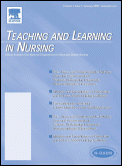
Teaching and Learning in Nursing
Advancing Nursing Pedagogy for Future LeadersTeaching and Learning in Nursing, an esteemed publication from ELSEVIER SCIENCE INC, serves as a cornerstone for advancing nursing education and practice. With its ISSN 1557-3087 and E-ISSN 1557-2013, this journal offers a platform for the dissemination of innovative research and best practices in nursing. It is recognized for its significant contributions within the categories of Fundamentals and Skills, Leadership and Management, and Research and Theory, consistently ranking within the top quartile in these essential areas for 2023. The journal's strategic focus on enhancing nursing pedagogy makes it an invaluable resource for researchers, educators, and practitioners alike, striving to bridge the gap between theory and application. Although it currently does not offer Open Access, its robust impact factor and critical insights foster a dynamic dialogue within the nursing community, making it a must-read for anyone dedicated to the evolution of nursing education. With an engaging scope that covers the latest trends and challenges in nursing pedagogy, it aims to equip the next generation of nursing professionals with the tools necessary for excellence in patient care and professional leadership. Explore this journal to stay updated on cutting-edge practices and contribute to the collective knowledge in nursing education.

Frontiers in Education
Connecting Ideas, Inspiring Change in Education.Frontiers in Education is a distinguished open-access journal published by FRONTIERS MEDIA SA, dedicated to the advancement of educational research and practice. Launched in 2016, this journal has quickly established itself within the field, attaining a Q2 ranking in Education for 2023, positioning it among the top-tier publications in the field. With a Scopus rank of #580 out of 1543, it lies in the 62nd percentile, highlighting its significance and reach within the scholarly community. Based in Lausanne, Switzerland, Frontiers in Education aims to provide a collaborative platform for educators, researchers, and practitioners to disseminate high-quality research findings and innovative educational practices. As an open-access publication, it not only champions the principles of accessibility but also enhances the visibility and impact of its published work. This journal is instrumental in shaping the future of education through rigorous research, critical analysis, and the promotion of best practices, making it an essential resource for anyone invested in the field.
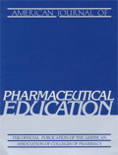
AMERICAN JOURNAL OF PHARMACEUTICAL EDUCATION
Inspiring Innovation in Pharmacy through Rigorous ResearchThe American Journal of Pharmaceutical Education (ISSN: 0002-9459; E-ISSN: 1553-6467), published by Elsevier, stands as a premier platform in the intersecting fields of pharmacy and education. Established as a vital resource since 1945 and converging through several pivotal periods, this journal has consistently garnered attention for its rigorous selection of research and insight, earning a distinguished ranking in the top quartiles in 2023 across multiple categories, including Q1 in Education, Q1 in Medicine, Q1 in Pharmacology, and Q1 in Pharmacy. Its impact within the academic community is evident, with impressive Scopus rankings placing it among the top in its field (4th out of 45 in Health Professions - Pharmacy). The journal's commitment to advancing pharmaceutical education plays a crucial role in shaping future professionals equipped with the latest knowledge and practices. Although it currently does not offer Open Access options, its rigorous peer-review process and high-impact content ensure visibility and engagement among researchers, educators, and students alike, making it an indispensable resource for those invested in pharmaceutical sciences.

Nurse Educator
Elevating Nursing Education for Enhanced Patient Care.Nurse Educator, published by Lippincott Williams & Wilkins, serves as a pivotal resource in the field of nursing education and practice. With an ISSN of 0363-3624 and an E-ISSN of 1538-9855, this esteemed journal has been contributing to the development of nursing professionals since 1976 and is recognized for its impactful articles, reflected in its 2023 Q2 category rankings across various nursing and educational domains. Nestled within the competitive landscape of academic publishing in the United States, its substantial Scopus ranking underscores its significance, particularly in Nursing Fundamentals and Skills (Rank #7/15) and general nursing fields (Rank #52/139). The journal's scope encompasses essential topics pertinent to nurse educators, including pedagogy, clinical practice, and exam preparation strategies, ultimately aiming to enhance nursing education and improve patient care outcomes. By providing an engaging platform for innovative research and best practices, Nurse Educator stands as an essential resource for researchers, educators, and students committed to advancing the nursing profession.
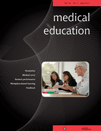
MEDICAL EDUCATION
Driving Excellence in Medical Training and Educational PracticesMEDICAL EDUCATION, published by Wiley, stands as a leading journal in the fields of education and medical training, holding a prestigious Q1 ranking in both the Education and Medicine (miscellaneous) categories for 2023. With an impressive impact illustrated by its 94th percentile ranking in Social Sciences Education, this journal has been pivotal in advancing research and discourse since its inception in 1966. Dedicated to enhancing the quality of medical education through scholarly articles, innovative methodologies, and evidence-based practices, MEDICAL EDUCATION provides a vital platform for educators, researchers, and practitioners. Although it does not offer open access, its comprehensive reviews and studies are invaluable resources for those committed to developing effective educational practices in the medical field. This journal is instrumental in shaping the future of healthcare education and fostering knowledge exchange among professionals.